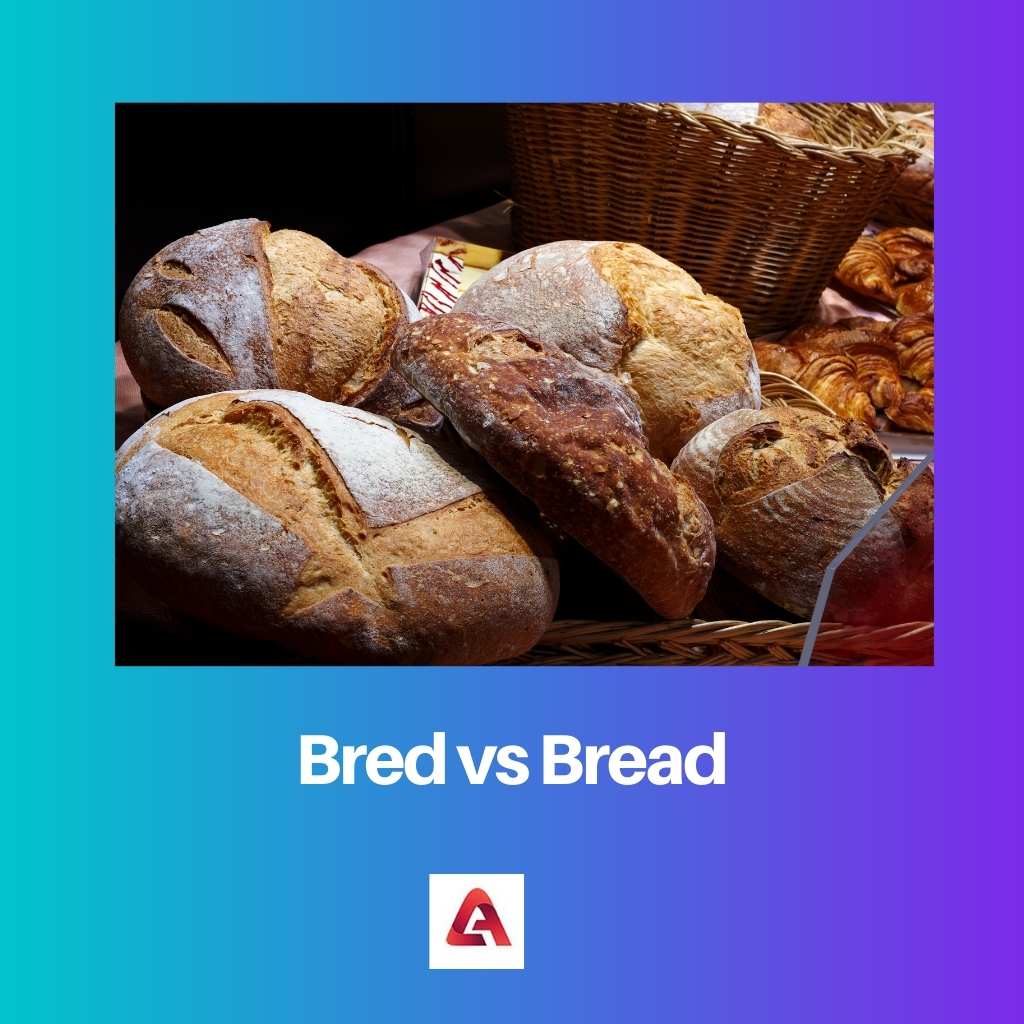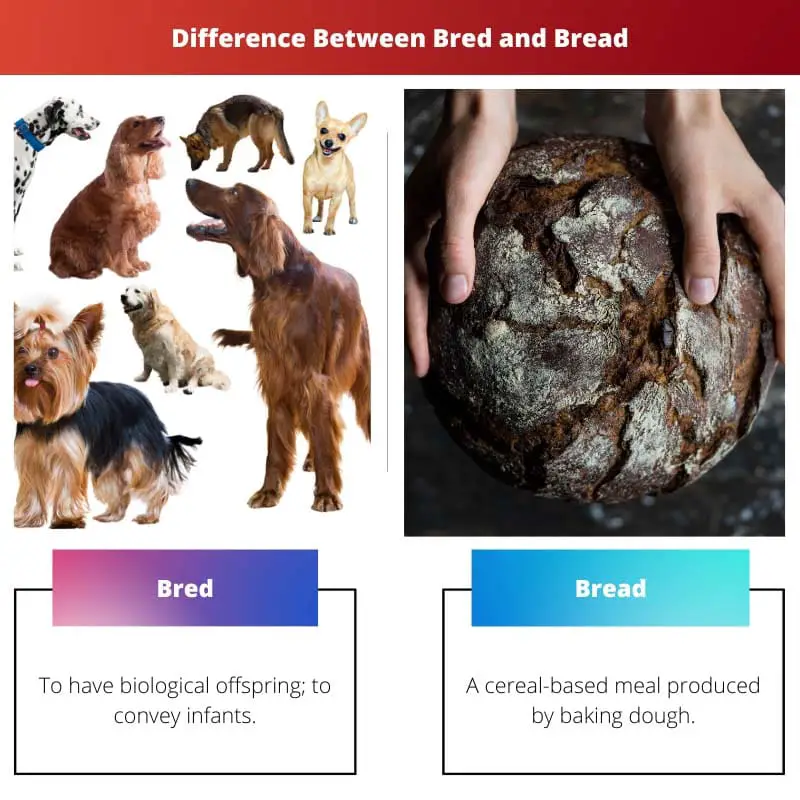The breeder that creates a breed would do this by choosing native animals from a hereditary stream that they believe have the required attributes to improve the breed pattern they are striving for.
Whereas bread is one of the earliest cooked meals. The starch coating on boulders used for crushing plants was discovered 30,000 decades previously in Europe.
Key Takeaways
- Bred is a term used mainly in Europe for flour-based food made from dough and leavening agents, whereas bread is used for any flour-based food baked or cooked.
- Bred is denser and heavier than bread and has a thicker crust.
- Bred is more commonly used in regional and traditional cuisine, while the bread is a more general and widely used term.
Bred vs Bread
The difference between bred and bread is that bred is a distinct group of domesticated animals that have a homogenous aspect, such as phenotypic, and/or other features that identify it from other creatures of the same genus. On the other hand, bread is a basic meal made from a knead of flour, grain, and water and baked. It has long been a staple of many civilizations’ diets. It is one of the earliest foods created by humans.

The bred type is constant enough that it can be rationally categorized, and when partnered among the category, the offspring generate the same variety.
When members of the same species are mated together, they transmit these predicted qualities as well as this capability to their progeny. Botanical genotypes are more used to refer to plant breeds.
Purebreds or mixed breeds are the progeny generated by mixing creatures of one bred with wildlife of some other breed. Bread has been important since the birth of civilization and is crucial in both spiritual observances and secular society.
Natural bacteria, substances like sodium bicarbonate, industrially manufactured fermentation, or high-pressure agitation, which forms the gas bursts that plump up bread, can all be used to force bread.
Additives are frequently used in contemporary bread to increase flavor, texture, color, shelf life, nourishment, and convenience of manufacture.
Comparison Table
| Parameters of Comparison | Bred | Bread |
|---|---|---|
| What is it? | To have biological offspring; to convey infants. | A cereal-based meal produced by baking dough. |
| In General | In general, to retain creatures and have them procreate in a manner that maximizes the traits of the following generation. | Meals; nourishment; intensive care in general. |
| Arrange | To arrange for selected animals to mate. | To assemble the bits for various sorts of bread. |
| Taken Care Of | To look after during childhood and adolescence; to raise. | to smother in breadcrumbs |
| Nature | To be created in the parental or womb; to be produced or grown, as offspring before birth. | To coat with bread granules before cooking; for example, battered cutlets. |
What is Bred?
A bred or breed is a distinct group of household mammals that have a homogenous structure, homogeneous temperament, and other features that identify them from other creatures of the same order.
Breeds are developed as a result of genetic seclusion and spontaneous adjustment to the habitat.
Considering the importance of breeds in animal herding and agribusiness, there is no one, professionally recognized interpretation of the terminology. Domestic animal breeds vary considerably from country to country and international norms.
A breed is thus not an empirical or physiologically verifiable categorization, but rather a concept of art used by communities of breeders who agree about what characteristics distinguish certain representatives of a defined species as part of an identifiable subclass.
Specific bred features also referred to as breed attributes, are transmitted and passed down from generation to generation in thoroughbred animals. As a result, all individuals of a similar breed share some genetic traits with the initial cornerstone animals.
A breeder might pick animals with the highest desired qualities to ensure continued conservation and growth of such features to sustain the breed.
At the same period, the breed will prevent animals with unattractive or non-typical breed features, such as flaws or genetic disorders.
The community within the same breed ought to have a significant amount of animals to keep the form within the standards stated without the need for coerced consanguinity.
What is Bread?
Bread is created from a wheat crust that is fermented with lactobacillus, allowed to flourish, and then burnt in an oven. The presence of gas bubbles in bread is explained by the inclusion of yeast.
Frequent or bread flour is perhaps the most ordinary crop used during the manufacture of bread, and it contributes the majority to the global food intake of any cuisine due to its significant quantities of gluten, which provide the dough slipperiness and flexibility.
Bread is one of the most ancient cooked foods. It’s conceivable that throughout the epoch, starch retrieved from root systems like sedges and lilies was put on a rocky outcropping, baked over a flame, and shaped into a rudimentary sort of flatbread.
The world’s earliest indication of bread-making has been discovered in Jordan’s northern wilderness at a 14,500-year-old Nubian settlement.
With the advent of the Paleolithic Era and the expansion of farming about 10,000 BC, cereals became the backbone of bread production.
The Sumerians cooked sourdough bread as ancient as 6000 BC. The Egyptians improved the method by incorporating yeast into the flour. The Sumerians started reportedly adding ash to the batter while it cooked.
There were several sweetening options accessible for ancient bread. The degree of sophistication in the culinary arts was seen as a mark of civilization by the ancient Egyptians, Persians, and Italians.

Main Differences Between Bred and Bread
- Bred is organized for specified animals to reproduce. Whereas bread is to stack the fragments for a wide assortment.
- Bred is to watch after or throughout childhood and teenage years; to nurture. Whereas bread looked after to sprinkle into breadcrumbs.
- Bred to be established in the father or aqueduct; to be developed or nourished, as infants preceding birth. Whereas bread is to spread with bread grains while cooking; for instance, crusted croquettes.
- Bred is to conceive reproductive spawn; to possess infants. Whereas bread is a cereal-based delicacy prepared by toasting batter.
- In general, bred is to sustain pets and have them interbreed in a direction that optimizes the attributes of the upcoming species. Whereas bread; veggies, sustenance, computationally intense concern in general.

- https://link.springer.com/article/10.1007/s00122-003-1502-y
- https://onlinelibrary.wiley.com/doi/abs/10.1002/jsfa.2740320109
